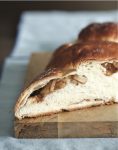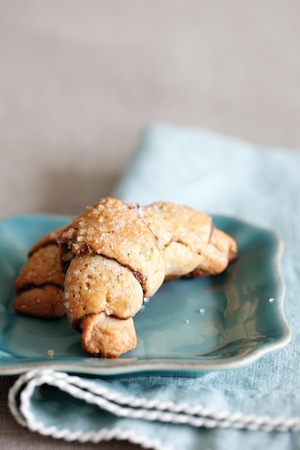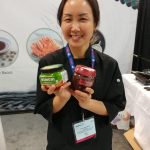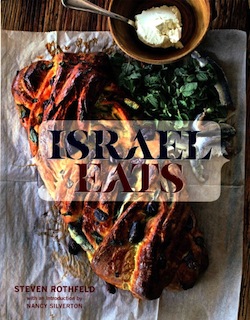What food, served with cooked beef, is an essential component of a traditional wedding dinner in southern Germany? It is also used in salad served with lamb dishes at Easter in Transylvania and other Romanian regions. In Serbia, it is an essential condiment with cooked meat, including roasted pig. In Slovenia, it is a traditional Easter dish, grated and mixed with sour cream, hard-boiled eggs or apples. And, in southern Italy, it is a main course with eggs, cheese and sausage. It is probably indigenous to eastern Europe but has been cultivated since antiquity and was known in Egypt in 1500 BCE.
One final hint, and you will know immediately. According to the Haggadah, we are to eat it to symbolize the bitterness of slavery in Egypt. “And they made their lives bitter with hard labour, in mortar and in brick, and in all manner of work in the field….” (Exodus 1:14)
Maror is one of the foods on the seder plate, which we bless then dip into charoset to symbolize the mortar the Israelites used to bind the bricks. Shaking off the charoset, we eat the minimum amount of maror, the volume of an olive.
Horseradish. The English word, coined in the 1590s, combined horse, meaning coarse or strong, and the word radish.
According to John Cooper in Eat and Be Satisfied: A Social History of Jewish Food, “the Mishnah enumerated five vegetables that could be utilized as the bitter herb for the seder service, all of which should have leaves. The five are chazeret, ilshin, tamchah, charchavina and maror.”
Chazeret refers to lettuce; ulshin is either endive or chicory or both; tamchah was a leafy, dull green herb also known as horehoud, which is used in cough medicine and liqueur; charchavina was either field or sea eryngo; and maror possibly a wild lettuce or type of cilantro. Sephardim interpret chazeret as Romaine lettuce.
Rabbi Alexander Suslin of Frankfurt, who died in 1394, was the first authority to permit the use of horseradish where lettuce was not available, although this vegetable was primarily a fleshy root that did not strictly conform with the halachic requirement of eating leaves. The Talmud also says, besides leaves, maror should have white sap and dull green foliage, neither of which is in horseradish. The medieval German rabbinic authorities appear to have identified horseradish incorrectly: merretich, in German, with merirta, the Aramaic form of maror, the Hebrew for bitter.
Prior to this, according to Gil Marks in the Encyclopedia of Jewish Food, Eliezer ben Nathan of Mainz, who lived from 1090 to 1170, mentions chrain (paste made with horseradish). Rabbi Eleazar ben Judah of Worms in Sefer ha-Rokeach (published around 1200) included it in his charoset ingredients.
It was not until Rabbi Yom Tov Lipman Ben Nathan Heller (1579-1654) of Moravia, in his commentary on the Mishnah, considered horseradish to be the tamchah mentioned in the Talmud. In Hebrew, it is called chazeret, which is on the talmudic list of accepted types of maror.
Horseradish is a root vegetable in the same family as mustard, wasabi, broccoli and cabbage. When the plant grows, it can reach 4.9 feet and is cultivated for its root, which has hardly any aroma. When the root is cut or grated, cells break down and produce an oil, which irritates the nose and eyes.
German immigrants in the late 1800s began growing horseradish in Collinsville, Ill., a Mississippi River basin area adjacent to St. Louis. This self-proclaimed horseradish capital of the world – this is where most of the world’s supply is grown, some six millions gallons annually – has been hosting the Horseradish Festival since 1988.
The first American Jewish cookbook, Jewish Cookery (1871), included a recipe for horseradish stew. When the Settlement Cookbook was published in 1901, horseradish sauce, beer and relish were included.
H.J. Heinz processed and bottled horseradish in 1869. In 1932, Hyman Gold and his wife, Tillie, processed and bottled horseradish in their Brooklyn apartment.
Today, Gold’s and other private labels produce 90,000 bottles a day of the classic plain and grated beet horseradish without sugar.
My husband likes to tell the story of coming home from school one day before Passover, at the age of 8, and going into the kitchen where his grandmother was grating the horseradish; she made horseradish almost every week. He jumped up on a chair, took one big whiff and fell over backwards! Thank goodness his father was in the room and caught him.
Sybil Kaplan is a journalist, lecturer, book reviewer and food writer in Jerusalem. She created and leads the weekly English-language Shuk Walks in Machaneh Yehudah, she has compiled and edited nine kosher cookbooks, and is the author of Witness to History: Ten Years as a Woman Journalist in Israel.







 Daykin published her first cookbook in 2013, Butter Baked Goods: Nostalgic Recipes from a Little Neighborhood Bakery, and her second in 2015, Butter Celebrates! A Year of Sweet Recipes to Share with Family and Friends, both via Appetite by Random House. Just last month, the U.S. edition came out from Knopf, with the subtitle “Delicious Recipes for Special Occasions,” and this reviewer received a copy.
Daykin published her first cookbook in 2013, Butter Baked Goods: Nostalgic Recipes from a Little Neighborhood Bakery, and her second in 2015, Butter Celebrates! A Year of Sweet Recipes to Share with Family and Friends, both via Appetite by Random House. Just last month, the U.S. edition came out from Knopf, with the subtitle “Delicious Recipes for Special Occasions,” and this reviewer received a copy.


 After Haaretz journalist Ronit Vered explains the history of Israel’s cuisine from the 1950s to today, Rothfeld and Silverton embark on a tour of Israel – Tel Aviv-Jaffa, the north, the centre, the south, Jerusalem and the Judean hills, concluding with the “ecosystem of Israel Eats,” meaning the people who contributed to the book.
After Haaretz journalist Ronit Vered explains the history of Israel’s cuisine from the 1950s to today, Rothfeld and Silverton embark on a tour of Israel – Tel Aviv-Jaffa, the north, the centre, the south, Jerusalem and the Judean hills, concluding with the “ecosystem of Israel Eats,” meaning the people who contributed to the book.
 Beauty adored me, but Bubbe Mary did not seem to have much time to see me. Also, Beauty was all about being healthy, using a lot of fresh fruits and vegetables in all her dishes. Bubbe Mary was all about recreating the dishes that made her feel closer to Old World traditions she left behind in Romania.
Beauty adored me, but Bubbe Mary did not seem to have much time to see me. Also, Beauty was all about being healthy, using a lot of fresh fruits and vegetables in all her dishes. Bubbe Mary was all about recreating the dishes that made her feel closer to Old World traditions she left behind in Romania.
